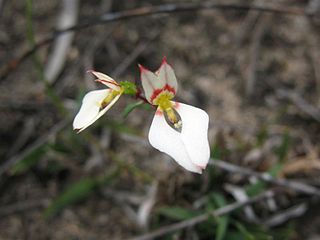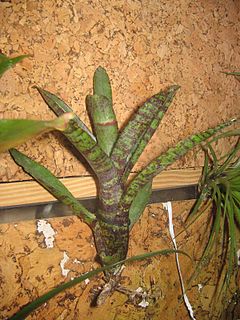
Eucalyptus pauciflora, commonly known as snow gum, cabbage gum or white sally, is a species of tree or mallee that is native to eastern Australia. It has smooth bark, lance-shaped to elliptical leaves, flower buds in clusters of between seven and fifteen, white flowers and cup-shaped, conical or hemispherical fruit. It is widespread and locally common in woodland in cold sites above 700 m (2,300 ft) altitude.
Fordia pauciflora is a species of legume in the family Fabaceae. It is a tree found in Peninsular Malaysia and Thailand. It is threatened by habitat loss.
Inga pauciflora, the guabita de río, is a species of plant in the family Fabaceae. The specific epithet pauciflora is Latin for 'few-flowered'. It is found only in Panama. It is threatened by habitat loss.
Leptolaena pauciflora is a species of flowering plant in the Sarcolaenaceae family. It is found only in Madagascar. Its natural habitats are subtropical or tropical moist lowland forests, subtropical or tropical high-altitude shrubland, and sandy shores. It is threatened by habitat loss. The specific epithet pauciflora is Latin for 'few-flowered'.

Agasthiyamalaia pauciflora is a species of flowering plant in the Calophyllaceae family. It was recorded in Travancore and Tirunelveli in 19th century India. It has not been recorded since. The specific epithet pauciflora is Latin for 'few-flowered'.

Balaka is a genus of 9 known species in the palm family, Arecaceae or Palmae. Seven species are native to the islands of Fiji and two to Samoa. The genus was first proposed and published in Annales du Jardin Botanique de Buitenzorg 2: 91. 1885, from two species originally in the genus Ptychosperma.
Axinaea pauciflora is a species of plant in the family Melastomataceae. It is endemic to Ecuador. Its natural habitat is subtropical or tropical moist montane forests. The specific epithet pauciflora is Latin for 'few-flowered'.
Brunellia pauciflora is a species of plant in the Brunelliaceae family. It is endemic to Ecuador. Its natural habitat is subtropical or tropical moist montane forests. It is threatened by habitat loss. The specific epithet pauciflora is Latin for 'few-flowered'.
Gonzalagunia pauciflora is a species of plant in the family Rubiaceae. It is endemic to Ecuador. The specific epithet pauciflora is Latin for 'few-flowered'.
Hirtella pauciflora is a species of plant in the family Chrysobalanaceae. It is endemic to Ecuador. Its natural habitat is subtropical or tropical moist lowland forests. The specific epithet pauciflora is Latin for 'few-flowered'.
Ilex pauciflora is a species of plant in the family Aquifoliaceae. It is a tree endemic to Peninsular Malaysia. It is threatened by habitat loss.
Shorea pauciflora is a species of plant in the family Dipterocarpaceae. It is found in Sumatra, Peninsular Malaysia and Singapore. It is threatened by habitat loss. The specific epithet pauciflora is Latin for 'few-flowered'.

Levenhookia pauciflora, the deceptive stylewort, is a dicotyledonous plant that belongs to the genus Levenhookia. It is an ephemeral annual that grows from 5–10 centimetres (2.0–3.9 in) tall with ovate to suborbicular leaves. Flowers are white and bloom from September to November in its native range. L. pauciflora is endemic to Western Australia where it grows in sandy soils in sandstone or granitic areas. The flowers of L. pauciflora resemble those of Stylidium ecorne and it has been said that S. ecorne mimics L. pauciflora to take advantage of its pollinators.

Vatica pauciflora is a species of tree in the family Dipterocarpaceae. The specific epithet pauciflora is Latin for 'few-flowered'.

Carex pauciflora, known as few-flowered sedge, is a perennial species of sedge in the family Cyperaceae native to Holarctic wetlands. The specific epithet pauciflora, refers to the Latin term for 'few flowered'.

Neoregelia pauciflora is a species in the genus Neoregelia. This species is endemic to Brazil. The specific epithet pauciflora is Latin for 'few-flowered'.
Tabernaemontana pauciflora is a species of plant in the family Apocynaceae. It grows as a shrub or small tree up to 6 metres (20 ft) tall, with a trunk diameter of up to 10 centimetres (4 in). The bark is pale grey to grey-brown. Inflorescences bear up to 15 flowers. The fragrant flowers feature white, sometimes yellow-throated, corolla lobes. The fruit is orange or yellow with paired follicles, up to 6 centimetres (2 in) in diameter.
Kopsia pauciflora is a tree in the family Apocynaceae. The specific epithet pauciflora means "few-flowered".
Croomia pauciflora is a plant species native to Florida, Alabama, Georgia and Louisiana. Croomia pauciflora is generally found in rich loams in forests.
Grevillea pauciflora, commonly known as the few-flowered grevillea, is a shrub of the genus Grevillea native to an area along the south coast in the Great Southern and Goldfields-Esperance regions of Western Australia.






